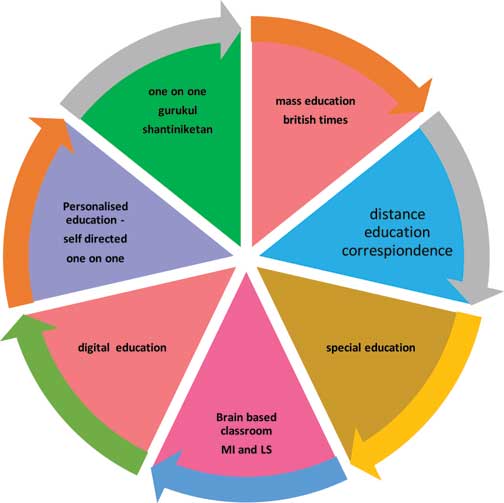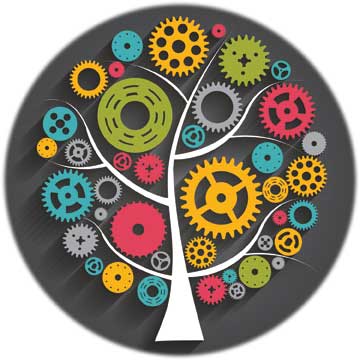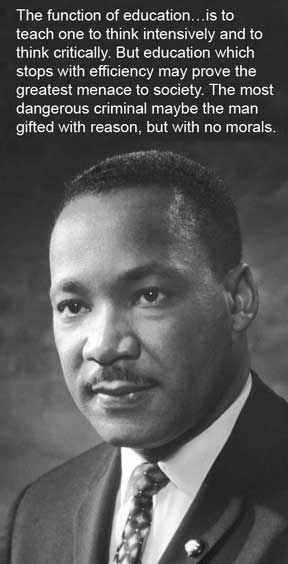Sheela Ramakrishnan
Trying to decipher what would have actually been revolutionary in the field of education set me on a path of reflection. My mind leaped across the ages – our ancient systems, Tagore, J Krishnamurthi, Maria Montessori, Froebel, the church schools of North India and South India – in one of which I studied and later taught, the central schools, the government schools, Howard Gardner, Daniel Goleman, Ken Robinson, the private schools, the inclusive schools, Finland, the international schools! My mind was a mélange of names, flavours and philosophies, some here, many more unnamed. It took time to find a pattern in the vivid images flashing through my mind.
As my thoughts slowly stopped churning, the following pattern is what stayed with me. I began to believe that there was no ONE definition of revolution – as service providers we need to respond to the needs of the society and therefore will always be evolving. Human beings are dynamic creatures and change is the only constant. What would have been very relevant at one time would not cut much ice today and even less tomorrow. As practitioners the question we need to keep reflecting on is – Are we being relevant? What would my student do with this tomorrow? For if we teach Today’s students the way we taught Yesterday’s, we rob them of Tomorrow! (John Dewey)
It started in India: We have always heard stories and seen images of rishis offering one on one education that was largely residential. Our gurukul system during the Vedic times, not only served the purpose of those in this region, but also attracted several students from other parts of the globe. Students and teachers lived together and experienced life together. Learning was practical and discussions encouraged to obtain different perspectives. Compensation was usually in the form of service to the guru or teacher who was strict and brooked no nonsense or indiscipline. Punishment was a norm in case of breaches. Respect to the guru was automatic – out of reverence and perhaps a little fear.
 It is relevant to recall that we have the best bank of knowledge on a vast range of subjects that is the subject of research even today in several countries across the world. The system did have strong merits and nurtured thinking minds. Modern gurukuls from the Anglo Vedic period steadily began attracting fewer students. Shanti Niketan is probably one of the few that still survives the vision.
It is relevant to recall that we have the best bank of knowledge on a vast range of subjects that is the subject of research even today in several countries across the world. The system did have strong merits and nurtured thinking minds. Modern gurukuls from the Anglo Vedic period steadily began attracting fewer students. Shanti Niketan is probably one of the few that still survives the vision.
The legacy of colonialism: The large-scale manufacture of labour that followed, and then paved the way for the advent of mass education in India. Gurukuls were systematically broken down and the Macaulay Way came home to roost. English took over the study of Indian languages. Subservience rather than curious discovery was a virtue. It served the purpose of our English rulers to feed large numbers of English-speaking workers into the workforce – the hangover still continues.
While I do acknowledge the strong positive influence of these schools – we continue to enjoy even today – one can’t help feeling that we abandoned what we were very good at just because someone beat it down and made us believe that we were no good. That is one of the reasons why we at a very deep level respect what comes from the West way more than what comes from the East.
This hangover has been hard to break and our system is still struggling with it.
Reaching out: As industrialization and education for a living gained ground, thanks to colonialism, a gap was felt by those who had to get to work and could not therefore complete their studies. This led to the launch of distance and self-learning courses, where benchmarks would be the same as for regular students, but would not have the advantage of the presence of a teacher to impart knowledge. These correspondence courses have helped lakhs of students obtain additional qualifications, thereby enabling them to rise in their career and better their salaries – as rises were more about qualifications than skills. More on the new avatar of this format later.
What about me? As Education for All became the norm, attention was drawn to those for whom the factory model did not work – those who needed to be taught differently, including those who were either physically or intellectually challenged or some who had learning pathways that did not follow the norm. And thus was born Special Education – a space that was devoted exclusively to meet the needs of this group. Higher education kept pace and introduced specialized training programs and soon there were schools where anyone who could not conform was placed. It is no wonder then that special schools were not the first option of either the parent or the student – unless there was no other way. I personally know of friends who decided to home school rather than place their children in a special school! We lost baby with bath water because of the stigma.
Realizing that the group was getting more marginalized than included, our government rolled out policies that directed our mass model to become inclusive. This meant not just those with challenges, but all those who needed to be included, who had been hitherto marginalized – gender, caste, socio-economic status, physical challenges, intellectual challenges – all had to be included in the regular stream. Special schools were seen as adjuncts to this model, providing support services that could not be managed by mainstream schools. Several institutions began to have special sections within their own premises. Segregation was frowned upon and inclusion began to gain momentum.
 The many brains: In the meanwhile, psychologists and researchers began to make new discoveries on the way our brains worked and why the mass model was showing large cracks in its implementation. As these findings began to be shared, educationists began to see the connection between what the research was saying and what was happening in the classroom. They began to understand why the system was failing so many bright minds and also unable to meet the needs of so many.
The many brains: In the meanwhile, psychologists and researchers began to make new discoveries on the way our brains worked and why the mass model was showing large cracks in its implementation. As these findings began to be shared, educationists began to see the connection between what the research was saying and what was happening in the classroom. They began to understand why the system was failing so many bright minds and also unable to meet the needs of so many.
Theories of Learning Styles, Multiple Intelligences and Right brained persons began to gather momentum and soon found resonance in the system. While the West of course went as far as to have brain compatible classrooms to cater to those needs, we in India began to use these learnings to implement them with in the mass model that we are following. The result was that those who had access to resources, and understood the theories and practice well could bring about a more inclusive and participative classroom. Several other smaller schools in the interiors where accurate information was scarce and resources inadequate, began to interpret theories in their own ways and use it for more mileage than actual practice.
This research began to impact our own educational policy in a big way – the country began to wake up to the idea that the only way out for India was to build entrepreneurs and thinking individuals than mere yes men! Our economy had opened, we were working in a collaborative global environment where creativity, innovation and a certain amount of audacious risk taking, was the name of the game than subservience. Our policy also began to talk of inculcating 21st century skills of collaboration, communication, creativity and critical thinking as the pillars of education and not just providing knowledge.
We must not also forget that by now the Internet had stormed the world, shrunk borders and Google became a verb! Knowledge was no longer the domain of teachers in a school context, it was available at the click of a button any time anywhere! That we have gone one step further with AI is just the tip of the iceberg. Teachers have had to reinvent themselves rapidly to retain their roles and find new purposes for education.
The digital era: It is no wonder then that suddenly, the world had become one big market place – thanks to the Internet. The old model of correspondence education took on a new avatar in the form of digital or online education. One can today, sitting in the comfort of one’s home or office, study any course rolled out by any university or educational organization and enhance one’s knowledge in a credible manner.
 While distance education had earlier catered only to higher education, the invasion of the Internet into our lives saw all kinds of programs being run for all age groups. Right from toddlers to senior citizens – the digital world became more and more inclusive! Interactive games to films to animation to podcasts to audio books – there was no end to what form learning could take!
While distance education had earlier catered only to higher education, the invasion of the Internet into our lives saw all kinds of programs being run for all age groups. Right from toddlers to senior citizens – the digital world became more and more inclusive! Interactive games to films to animation to podcasts to audio books – there was no end to what form learning could take!
With the world shrinking and work canvas going global, especially in the IT sector, the country began to have a large number of expats working in India. This led to schools getting affiliated to international curricula under the umbrella of international schools. These schools embraced the best of all worlds – physical and digital. Technology was a part of the process.
Back to square one: Since the focus suddenly moved from knowledge to skills, it also became apparent, when viewed in conjunction with modern research, that every individual was endowed with innately different potentials for learning and development of skills. These talents and attributes had to be nurtured exclusively as personalized education – one on one!
The purpose of education as a means to develop the individual and not just build bodies for a living has once again taken shape. It is reflected in the educational policies that the nation has rolled out. The need for practical understanding of knowledge beyond books has been underscored. The role of the integration of the head, heart and hands has been established. The need to look at learning holistically and not just as subjects learnt in silos has found ground in pedagogical approaches. Personalized educational plans, individual education plans, customized education plans, activity based learning, interdisciplinary approach, inclusion – all these terms were beginning to come together and gather a whole new meaning. The new gurukul was unfolding!
New normal: And then Covid19 happened! If there was one industry that had to turn on its head overnight, it was education! A traditional industry, where acceptance of technology was extremely low barring the elite schools, educators had no other option but to adapt rapidly, adopt technology and launch online classes across the board! For once, school leaders were less equipped than their team! Educators were getting innovative in unprecedented ways! They were the true warriors! Parents realized that taking classes for children was not an easy task. They sat in on their children’s classes and from being critical of what was not being done, they turned into admirers of the way the system was evolving to suit the new normal. We are now faced with schools opening to a blend of both worlds when they reopen – physical classes for socialization and online classes for knowledge.
In the midst of this, NEP 2020 was released which reflected the way India was thinking and where she wanted to go. Early childhood education that had so far been outside the purview of the national agenda found its rightful place in the learning ladder. Developmental milestones are recognized and restructuring of the levels has been carried out. Practical application has been given its rightful place and internships are encouraged from as early as grade 6. That for an insightful thought process to develop, learning has to be connected to daily life and be more holistic, has been brought out in the proposed multidisciplinary or theme-based approach.
The real revolution: But the one aspect that the pandemic threw up was the need to develop our inner strength. From being a nation that had to be taught the meaning of work-life balance, families began to spend a lot more time together. Many were lucky to work from home, many had to leave jobs and locations and many had to contend with being redundant. People found it hard to cope with the blurred lines between home and work. Some families sailed through these times by redefining home roles and expectations deftly. Some struggled and some gave up and took extreme steps in the bargain. Social and Emotional Learning was a big piece in the puzzle that needed to be filled. To me this was a silent revolution (we did have life skills and value education in the curriculum) that has now come to the fore. SEL is here to stay. Counsellors have got their due and the power of mind over matter has been established. That the goal of education is not just to earn a living has been proven. An education that does not touch the heart is no education at all – said Aristotle and Martin Luther King Jr went a step further with these lines:
 I look at the future with hope. With the world-wide launch of ISO 21001, an audit standard exclusively for education in which India has been a front runner, with the Human Resources Ministry being renamed as the Ministry of Education, the road is set clearly for India to reclaim her glory!
I look at the future with hope. With the world-wide launch of ISO 21001, an audit standard exclusively for education in which India has been a front runner, with the Human Resources Ministry being renamed as the Ministry of Education, the road is set clearly for India to reclaim her glory!
The author is an Advisor to schools in school transformation, curriculum development and classroom methodology. She is the co-author of four series of textbooks published by the OUP, a certified ISO 21001 auditor, a counsellor and trained e-coach for students with anxiety from the Stanford School of Medicine and trained in Creative Thinking in the UK and Activity Based methods of teaching in Malaysia and Thailand. She can be reached at sheela.ramakrishnan@gmail.com.
